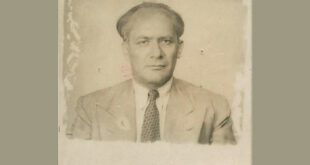Stalin and Mao, the Kuril Islands and Japan
(The value of the Kuril Islands in the negotiations on the Sino – Soviet Treaty of 1950)
Background and start of negotiations (16.12.49)
14 August 1945, ie 6 days after the Soviet Union declared war on Japan (9.08.1945 g) the Soviet Union and the Kuomintang government of China signed a Treaty of friendshipand Alliance. “It was the fixed purpose of reaching a joint military victory over militaristic Japan, that was a conscious reaction of both countries to the problem of the end of the Second world war and the postwar settlement” (see I. Rogachev. “Russian – Chinese Treaty on good-neighborliness, friendship and cooperation: results of the first year” // Journal “problems of the Far East.” No. 4, 2002. P.21).
One of the consequences of world war II in Asia and the Pacific was the Chinese revolution during which the Communist party of China (CPC) defeated the nationalist Kuomintang party. This victory in the state legally were issued by proclamation on 1 October 1949 the people’s Republic of China (PRC). The next day (2 October 1949), the Soviet Union recognized the PRC.
Core to the strategy of Stalin in the far East in this period was the possession of a non-freezing harbour and sea port, giving access to the Pacific ocean. Freezing harbour in Vladivostok do not fully meet these criteria.
Being strategic allies and fearing the increasing power of the United States in Asia, China and the USSR needed the legal registration of their Union, moreover, all existing contracts of the USSR with China as if “hung in the air”, because the attitude of the new leadership of China to the old contracts were for the Soviet Union is unclear. Namely, in accordance with the contract, 1945, concluded with the leadership of the Kuomintang of China, the Soviet Union for 30 years, leased the naval base of Port Arthur (Lushun) and got the rights to the Chinese-Changchun railway (CJD) with the end point of Dalny (Dalian), providing a land link to Port Arthur from Soviet territory.
In mid-December 1949, the Chairman of the Central people’s government of the PRC (he is the Chairman of the CPC Central Committee – the ruling party), Mao Zedong arrived in Moscow for talks on the Union and entering into a new contract.
Stalin initially reacted to the idea of a new Treaty in the negative, insisting on the preservation of the Treaty of 1945. He December 16, 1949, said: “This contract is concluded between the Soviet Union and China in accordance with the Yalta agreements,” therefore, the Union “agreed not to change any articles of this Treaty, since, change at least one article, perhaps this would give legal clue for USA and England to put the question of the revision of articles of agreements of the Kuril Islands, the southern Kuril Islands and other articles”. (CIT. at work, Shen Zhi-Hua, “the Clash and resolution of interests in the negotiations on the Sino-Soviet Treaty of 1950,” / / Journal “Problems of the Far East”, No. 4, 2002. P. 122. The author refers to the Archive of the President of the Russian Federation, f. 45. op. 1, D. 329, L. 9_17.)
At the meeting with Mao on 24 December 1949, Stalin ignored a question about the new Treaty with China.
The development of the negotiation process (2.01.50)
However, by the beginning of January 1950 Stalin made concessions. 2 January 1950, he sent Molotov and Mikoyan to the country, where for three weeks he lived Mao Zedong. The messengers announced to the Chinese guest about the, the Soviet Union agreed to sign a new Sino-Soviet Treaty.
The reason for the change of position was that under the already existing situation of the cold war for the security of the USSR in the Far East region for its strategic interests in Asia was an extremely important question, will join China to the socialist camp headed by the Soviet Union or not.
The reason for the change of position was pressured Mao to Moscow on the background of the spread to the West of the rumor that Mao Zedong is “under house arrest”, but this time, England, Burma and India are preparing to establish diplomatic relations with China. Clearly, releasing the head of China with empty hands meant to push him away.
The installation of Stalin in this regard, the Ministry of foreign Affairs of the USSR, was quite controversial. On the one hand, it was necessary in the new Treaty noted that prisoners
14 Aug 1945 in Moscow an agreement on CJD, Port Arthur, Dalny (Dalian) remain valid. On the other hand, Stalin agreed to the withdrawal of Soviet troops from the naval base of Port Arthur after the conclusion of a peace Treaty with Japan, i.e. the actual change of the agreement of 1945.
Therefore, in the Soviet draft 5-9 January 1950, the Soviet foreign Ministry, proposed the formula: “…currently in Port-Arthur and far of the Soviet troops for 2_3 years after the entry into force of this Treaty are completely removed within the Soviet Union. The withdrawal of troopswill begin in 1950″. It was said that after signingthe peace Treaty with Japan an agreement on Port-Arthur and far reviewed.
Of the Central Committee of the CPSU(b) on 22 January 1950 approved projects 12 documents, compiled by special commissions, on issues that could be addressed on the Sino-Soviet negotiations. In this new draft agreements on Port Arthur, and far CJD not approved. The Soviet side believed that, first, the agreement (1945) work, and the new agreement on Port Arthur and the far should be considered after the conclusion of a peace Treaty with Japan. It should be recalled that the San Francisco peace Treaty post-war borders in Asia was prepared by the allies and was imprisoned in the autumn of 1951.
20 Jan 1950 in Moscow at the head of the government delegation arrived, Zhou Enlai. At this time he was also the Premier of the State Administrative Council of the Central people’s government, foreign Minister and Vice-Chairman of the Chinese people’s political consultative conference (NP KSK).
January 22, Zhou Enlai took part in the third official meeting of Stalin and Mao Zedong. The parties have agreed about conclusion of a new Sino-Soviet Treaty and, in particular, on the inclusion of provisions on prevention of the aggression of Japan.
26 Jan Chinese for the Soviet side suddenly proposed a draft “Agreement on Port-Arthur and far of the Chinese-Changchun railway”.
In the draft of the Chinese side in the article regarding the withdrawal of Soviet troops from Port Arthur after the conclusion of a peace Treaty with Japan, it was added an additional condition: “If for some reason delayed the conclusion of a peace Treaty with Japan, and the term of this agreement will exceed three years and the corresponding contract is not concluded, the Soviet troops immediately removed from the area of Port Arthur,”… the Main thing here was, во0первых, that the Soviet Union was refused the lease of Port Arthur as a naval base renounced all rights and title in the far and CJD and at the same time declared that all the above rights and responsibilities of returning people’s Republic of China.
Second, all property in the far and near Port Arthur, which currently is in the possession or lease of the Soviet Union, was adopted by the government of China.
Thirdly, three years after the conclusion of a peace Treaty with Japan or expiration of this agreement, the Soviet government immediately transfers on a grant basis in the property China CJD and all property belonging to it”.
(see Shen Zhihua, “the Clash and resolution of interests in the negotiations on the Sino-Soviet Treaty of 1950.” //Journal “Problems of the Far East”, No. 4, 2002. P. 126).
The Soviet side had largely accepted the Chinese proposal, putting forward his proposal to the Soviet far East and Central Asian republics, on the one hand, and on the Chinese territory of Manchuria adjacent to the Soviet Far East, and the territory of Xinjiang, adjacent to Soviet Central Asia, on the other hand, should not be granted to foreigners concessions and should be allowed to citizens and capital from third countries to participate in entrepreneurial activities. This so-called “supplementary Agreement” the Chinese side adopted.
The conclusion of the contract (14.02.50). The significance and consequences of
On February 14, 1950, Zhou Enlai on behalf of China signed the Sino-Soviet “Treaty of friendship, Alliance and mutual assistance” for a period of 30 years.
Both countries expressed their resolve to combine their efforts for a joint struggle for the maintenance of peace and security of peoples to resist aggression by Japan, and provide mutual assistance in case of attack of Japan or alliedwith her state for one of the parties.
The USSR and the PRC agreed to pursue in cooperation with other allied powers peace Treaty with Japan; not to participate in a hostile coalitions, to consult on major international issues.
At the same time, agreements were concluded: on the donation of the Soviet Union to China of the rights of joint management CJD with all belonging to the road property;
– the withdrawal of Soviet troops from Port Arthur (now lüshun) and transfer it to China before the end of 1952;
– on the transfer to China of Soviet property in the city of Dalny (today Dalian);
– to grant the Soviet Union, China long-term of the associated loan of 300 million U.S. dollars to pay for the supply of equipment from the USSR.
Thus, the winner turned out to mostly China. Were secured its sovereignty and economic interests.
For Stalin the conclusion of the contract meant that after 1952 the Soviet Union would be deprived of the ice-free port and access to the Pacific ocean, i.e. goal, arising from the Yalta conference, a victorious war in Asia and the contract with the previous government of China in 1945.
Hence sharply increased the strategic importance of the Kuril Straits as a more Northern, but still exit into the Pacific ocean. Moreover, the Soviet troops who had potential access to ice-free ports of Korea, were withdrawn from that country in 1948.
Subsequently, on 15 September 1952, i.e. during the life of Stalin, the two sides exchanged notes on the extension of the term of the joint use of Port Arthur, 12 Oct 1954 – N. Khrushchev – was signed communiqué on the withdrawal of Soviet troops from Port Arthur to may 31, 1955, which was done in may of next year.
In addition, the Soviet Union in the short term, lost property, transport arteries Harbin – Dalian Port Arthur and the immediate influence in North-East China.
Stalin was forced to change its policy on the Korean Peninsula. Is Chinese ice-free ports, he was forced to focus on control over the Korean ports. Therefore, although the Soviet troops at this point, and left North Korea (DPRK), and in September 1949, the Politburo of the CPSU (b) even adopted a special decision that forbade North Korea to conduct military activities near the 38th parallel, which was the delimitation of Soviet and American zones of responsibility, Stalin 30 January 1950, went to meet Kim Il sung.
On this day, Stalin gave him the telegram with the actual agreement to negotiate. (Kim Il sung before repeatedly and harshly demanded a meeting with Stalin to discuss the problem of reunification of Korea). Korean war involving the Soviet Union, China and the United States began in the summer of 1950 and in 3 years took the lives of over 1 million people.
What were the strategic acquisition of Stalin and the Soviet Union?
First, China at the conclusion of the new Sino-Soviet Treaty recognized the independence of the Mongolian people’s Republic (Outer Mongolia – in Chinese terminology). The Soviet Union is very, very needed. Thus, the was strengthened in the international arena, the reputation of a reliable Soviet ally.
In addition, China agreed to the independence of Mongolia from China, i.e. curbing their potential territorial claims based on the fact that since the XVII century to 1911, it was actually part of China.
Second, China was included in the socialist camp headed by the Soviet Union, in terms of the cold war gave the opportunity to have influence in Asia to counter the United States. We can say that, by and large, the loss
Northeast China was not comparable with the value of the whole of China for the security of the Soviet Far East.
The United States took revenge on the Soviet Union and did not allow mainland China (PRC) in the San Francisco peace conference on the design of the postwar borders. In solidarity c China, the Soviet Union refused to sign the San Francisco peace Treaty. Envisaged initially negotiated the transfer of the Kuril Islands from Japan to the Soviet Union were the efforts of the United States oiled. In the Treaty of 8 September 1951 was only stated that “Japan renounces all rights, title and claims to the Kuril Islands and the part of Sakhalin island and the adjacent Islands, sovereignty over which Japan acquired by the Treaty of Portsmouth of 5 September 1905″ (between Japan and Russia. – S. P.).
In the same article 2 of the Treaty kept Japan’s renunciation of all rights, title and claims to Formosa and the Pescadores Islands (the item “in”). Formosa is a modern Taiwan, and the Pescadores Islands is Chinese 64 rocky island with an area of 127 sq. km in the Taiwan Strait. Now they are called Pinholed. So intricately entwined Kuril Islands and the Chinese in the history of the postwar world.
What conclusions can be drawn from this little-known story?
First, it should be noted the highest level of geo-strategic thinking of the Soviet leader Stalin, to consider the desirable relations with China through the prism of
their own territorial security. Stalin was a compromise. This is evidenced consent to the abandonment of Port Arthur, and Far KJD. But these compromises did not concern the territory of the Soviet Union, formed after the Second world war.
But his successors (N. Khrushchev in 1956_1959., Gorbachev in 1991, Yeltsin 1991-1999.;) erroneously believed that the so-called “peace Treaty”, for the different kinds of promises, you can sacrifice
The lesser Kuril ridge.
Secondly, it is obvious that Stalin clearly divided the gains obtained during the war, permanent (to whom, doubtless, he took southern Sakhalin and the Kuril Islands) and temporary (a naval base in Finland, China, etc.).
Thirdly, history has proven the temporality and fluidity of allied relations. The Alliance with China concluded 30 years, in the early 60-ies greatly weakened, and in 1968-1970 our country moved to a military confrontation (at lake Zhalanashkol in Central Asia, Sino-Soviet – far East).
By and large, Russia has only two true and loyal ally.
It is the army and Navy. Moreover, a strong and modern army and Navy.
All this clearly stemmed from the events associated with Iraq.
Therefore, all who are committed to the territorial integrity of Russia, should support the strengthening and re-equipment of our army and Navy,
the fight against all types of embezzlement and mismanagement, weakening the country.
The story always grows in the present.
/”Region”, Joins, No. 12 (277), March 27, 2003







